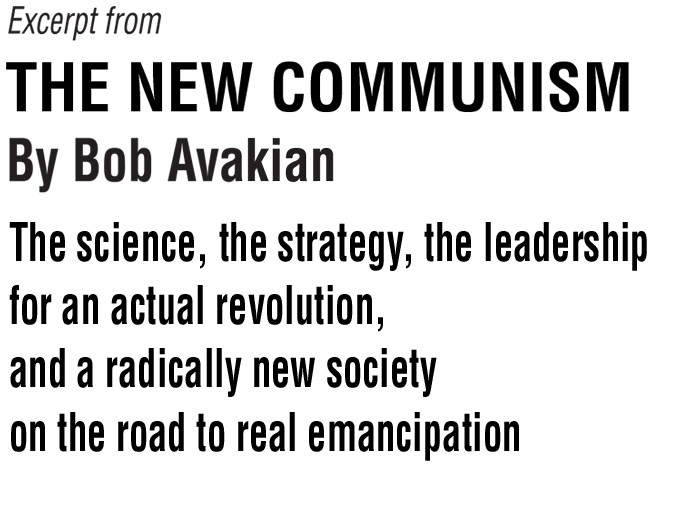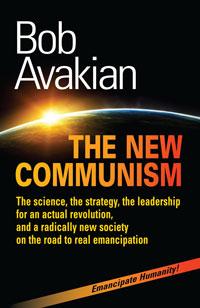
The following is an excerpt from the work by Bob Avakian, The New Communism. In addition to this and other excerpts posted on revcom.us, we will be running further excerpts from time to time on revcom.us. These excerpts should serve as encouragement and inspiration for people to get into the work as a whole, which is available as a book from Insight Press and as a PDF online at revcom.us.


This excerpt comes from the section titled "III. The Strategic Approach to An Actual Revolution."
In this connection, we have to recognize the important potential role of youth. It’s true that, right now, a lot of the youth are not in a very good place—or it’s hard to tell what place they’re in, because you can’t get their faces out of their phones! Nonetheless, it’s not the case that they never think about anything bigger than their apps. In any case, they still have the qualities of youth. And, in a minute, I’m going to come back to the George Carlin point that I referred to earlier. There is definitely a struggle to be waged with youth, and the potential for something positive to come out of this, because youth are at that crossroads in life where the question of what your life is going to be about does pose itself, objectively, and many do wrestle with that question. But right now, as I spoke to earlier, even the better parts of this are mainly funneled and channeled into making your way within the world as it is, or giving up on doing so. So there is a big struggle to be waged with these youth—to inspire them, but also to rupture them out of the pit and the rut into which they’re cast and maintained. And—here comes the George Carlin point: He’s not gonna say that the youth should turn against their parents, the way they did in the 1960s, is he? Well, yes, he is. But the way youth turned against their parents in the 1960s was not just to consign their parents to the garbage dump, as hopelessly backward and reactionary. It was to break with the way the parents were conditioning them to just go along with the way things were, and it involved struggling like hell with your parents about these big questions in the world, and to try—not without any success—to win them over to a significant degree, the parents and the older generation. Of course, we do have to recognize that things now are not exactly the same—things are not posed the same way, and they’re not spontaneously nearly as favorable as the coming together of things, the conjuncture, that turned into the ’60s movement—but I still think there is a question of the role of youth here, because youth are not so riveted into the way things are—and we have to think creatively and work creatively to find the ways to bring that forward, to bring forward the positive elements in that and to further develop them.
Speaking about parents today, particularly parents in the middle strata, there’s another thing you never had back in the day—at least not on anything like the scale on which it exists now—this phenomenon called “helicopter parents,” hovering all around the affairs of their kids, even when they go off to college. You hear all these professors complaining because, if the professors have the nerve to give the kid a B+ instead of an A, the parents contact them and complain about the grade they gave their kid. This kind of shit has got to go: What kind of self-respecting youth wants to have “helicopter parents” hovering around?
This is going to involve a lot of struggle—it’s not going to happen just because youth are youth. The youth, too, are shaped by the larger things going on in the world at any given time, and some of the youth, in certain periods, can be quite bad. So, it’s not some kind of romantic idea about youth, but I do think there’s still that contradiction of being at that crossroads of life, objectively, and that is something we have to think about, and work on, from a strategic standpoint.
And, within the broader category of youth, there is the particularity of students, including students at the more elite colleges. There is a reason why, historically, whenever there’s been any kind of radical movement in society, or revolutionary movement, students have been a significant part of and played a significant role in that. But my sense is that we have not put ourselves, in the way we need to, to figuring out, and carrying out, a systematic approach to bringing forward a radical student movement and a real revolutionary and communist current within that. We have not applied ourselves, the way we need to, to dealing with the contradictions involved in that. There are the qualities of youth, and the qualities of students—wanting to search out things for themselves, not wanting to be told what to think, and so on—there are all those kinds of things, which are not entirely negative by any means, even with all this relativist nonsense going on. From a strategic standpoint, we certainly shouldn’t have an attitude that critical thinking, even when it’s turned against us—that is, even when it leads to hard questions about what we are setting out to do—is negative in its main aspect. But we also shouldn’t tail this. We have to know how to work on these things. As a movement, as a party, we have to develop a more systematic approach to this. You can’t go from no radical student movement to a mass radical student movement in one week or one month—although it does need to be emphasized that there are situations when a great deal needs to be, and can be, achieved in a short, telescoped period of time, with systematic work. In fact, this is one of those times, and we have to put ourselves to it. We have to develop concretely, and actually implement, a way of going to work on this, because I will say again that there will never be a revolution without a significant component of a radical student movement, within which the pole of revolution and communism is a significant and growing force: both a force of attraction and also a force that’s contending within that student movement, as well as in the broader society, fighting to win people to communist revolution. I’m going to talk about this some more when I get to the question of leadership, but people who work in the realm of ideas and who propagate ideas in various ways have a disproportionate influence—an influence greater than their numbers—in terms of how they can affect society. This is something that can be wielded on behalf of one program or another—ultimately one class and one system or another. And we have to go to work on developing a force that’s actively wielding this ability and this influence for the revolution we need.
Contents
Publisher's Note
Introduction and Orientation
Foolish Victims of Deceit, and Self-Deceit
Part I. Method and Approach, Communism as a Science
Materialism vs. Idealism
Dialectical Materialism
Through Which Mode of Production
The Basic Contradictions and Dynamics of Capitalism
The New Synthesis of Communism
The Basis for Revolution
Epistemology and Morality, Objective Truth and Relativist Nonsense
Self and a “Consumerist” Approach to Ideas
What Is Your Life Going to Be About?—Raising People’s SightsPart II. Socialism and the Advance to Communism:
A Radically Different Way the World Could Be, A Road to Real EmancipationThe “4 Alls”
Beyond the Narrow Horizon of Bourgeois Right
Socialism as an Economic System and a Political System—And a Transition to Communism
Internationalism
Abundance, Revolution, and the Advance to Communism—A Dialectical Materialist Understanding
The Importance of the “Parachute Point”—Even Now, and Even More With An Actual Revolution
The Constitution for the New Socialist Republic in North America—
Solid Core with a Lot of Elasticity on the Basis of the Solid Core
Emancipators of HumanityPart III. The Strategic Approach to An Actual Revolution
One Overall Strategic Approach
Hastening While Awaiting
Forces For Revolution
Separation of the Communist Movement from the Labor Movement, Driving Forces for Revolution
National Liberation and Proletarian Revolution
The Strategic Importance of the Struggle for the Emancipation of Women
The United Front under the Leadership of the Proletariat
Youth, Students and the Intelligentsia
Struggling Against Petit Bourgeois Modes of Thinking, While Maintaining the Correct Strategic Orientation
The “Two Maximizings”
The “5 Stops”
The Two Mainstays
Returning to "On the Possibility of Revolution"
Internationalism—Revolutionary Defeatism
Internationalism and an International Dimension
Internationalism—Bringing Forward Another Way
Popularizing the Strategy
Fundamental OrientationPart IV. The Leadership We Need
The Decisive Role of Leadership
A Leading Core of Intellectuals—and the Contradictions Bound Up with This
Another Kind of “Pyramid”
The Cultural Revolution Within the RCP
The Need for Communists to Be Communists
A Fundamentally Antagonistic Relation—and the Crucial Implications of That
Strengthening the Party—Qualitatively as well as Quantitatively
Forms of Revolutionary Organization, and the “Ohio”
Statesmen, and Strategic Commanders
Methods of Leadership, the Science and the “Art” of Leadership
Working Back from “On the Possibility”—
Another Application of “Solid Core with a Lot of Elasticity on the Basis of the Solid Core”Appendix 1:
The New Synthesis of Communism:
Fundamental Orientation, Method and Approach,
and Core Elements—An Outline
by Bob AvakianAppendix 2:
Framework and Guidelines for Study and DiscussionNotes
Selected List of Works Cited
About the Author